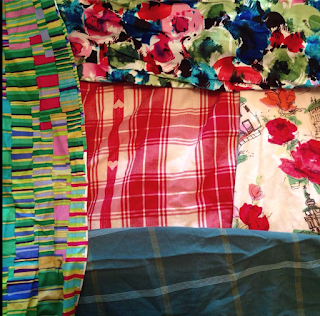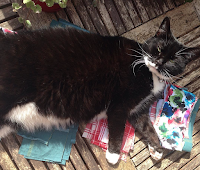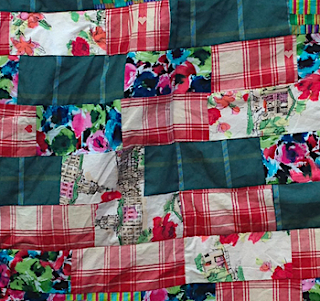At the weekend I finally finished my first – and possibly only – patchwork quilt. It took five hours to sew the patchwork, backing fabric and wadding together, and to make and attach the binding.
The project began about six months ago when I borrowed The Quilting Book (DK, £25) from my local library to see if there was a patchwork pattern simple – and swift – enough for me to follow. The book was due back before I'd started so I took a pic of the brick quilt pattern (which looks like brickwork except all the 'bricks' aren't the same size). It's designed to work with a fabric jelly roll (pre-cut fabric pieces rolled up together) but I didn't have one of those; I had an assortment of fabric leftovers and old clothes.
 Clockwise, from the top: leftover fabric from sewing a Colette Sorbetto top, an old skirt of mine, an old shirt of OH's, leftover fabric from sewing a Prima pattern top, and, in the middle, an old dressing-gown given to me ages ago by my step-grandma.
Clockwise, from the top: leftover fabric from sewing a Colette Sorbetto top, an old skirt of mine, an old shirt of OH's, leftover fabric from sewing a Prima pattern top, and, in the middle, an old dressing-gown given to me ages ago by my step-grandma.The wadding came from Hometown, Rochester, along with advice on why it didn't matter in the slightest if the quilt wasn't perfect, and the backing fabric was from Croft Mill.
 Next I started cutting the fabric into strips. The sun was out, so I did a bit in the garden, at which point my cat decided to 'help' by lying on the piles of pieces. (She enjoys lying on the finished quilt too.)
Next I started cutting the fabric into strips. The sun was out, so I did a bit in the garden, at which point my cat decided to 'help' by lying on the piles of pieces. (She enjoys lying on the finished quilt too.)When I came to sew the backing fabric, wadding and patchwork layers together, I first laid them out (on the living room floor, again). I pinned them together (taking blogger Flossie Teacakes's advice to pin from the centre, in concentric circles).
I machine-stitched around the edge, then came the quilting. Taking my friend Kirsten's advice, I started at the centre point. She's very meticulous and methodical: perfect atrributes for a patchworker and quilter. (I commissioned her to write this beginner's guide to patchwork and quilting). I stitched 'in the ditch' (along the existing seam lines) lengthays and widthways at the centre, then halfway between the centre lines and the edges to give 16 quilted squares.
Finally, I made some binding for the edges, by cutting six metres of 12cm-wide backing fabric, then ironing in half, then folding each side into the centre. It doesn't need to be bias binding because it's for a straight edge, thankfully. I've made bias binding and it takes even longer!
Given that it was my first quilt, and that, as stated above, patchwork and quilting are unsuitable crafts for me, I wasn't expecting it to turn out perfectly. And it didn't!
• One of the hardest things was placing each fabric piece so that it didn't touch another of the same pattern. I planned the layout by laying the fabric pieces in strips on the living room floor, then pinned them together, rolled them up, and put them on the shelves, in order. However, once I'd sewn the 'bricks' into strips, when I came to sew the strips together it seemed impossible to prevent pieces of the same fabric from appearing next to each other, despite my careful planning on the floor. In the end I pegged the strips out on the washing line as it was faster to move them around. However, I still ended up with unwanted matching patches.
• When I laid the backing fabric, wadding and patchwork layers out on the floor, I laid them backing fabric first, then wadding, then patchwork layer. I pinned them together, then I thought, no, the patchwork has to be wrong side up, so I laid it out and pinned it again. Then I made a mini version out of one fabric brick, and small pieces of wadding and backing fabric and realised that wouldn't work, so laid and pinned it one final time. (And after I'd done that I realised I was right the first time, because seeing the raw edges doesn't matter because they're being covered with binding...)
• I forgot to leave a gap when I machine-stitched around the edge of the quilt layers, so had to unpick it to turn it right side out.











